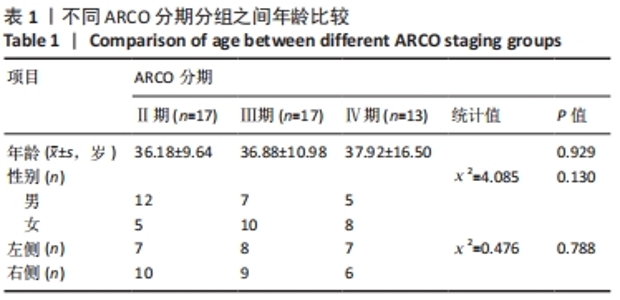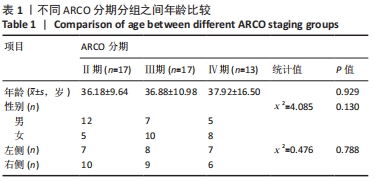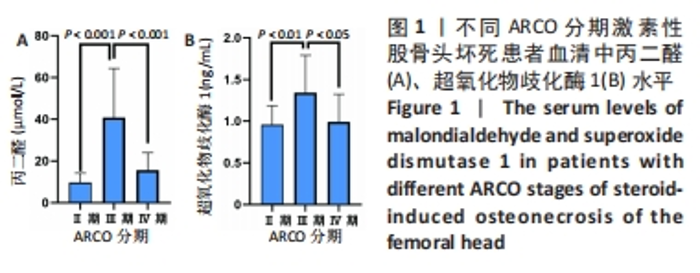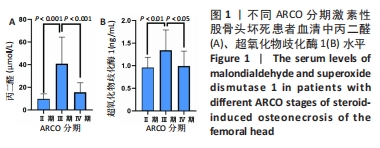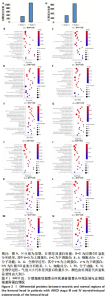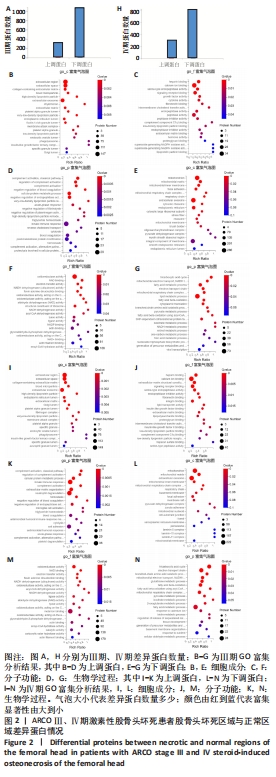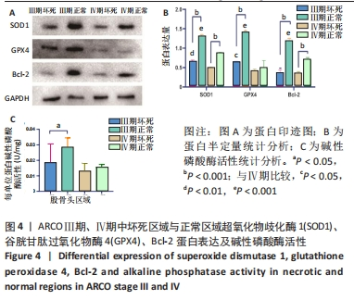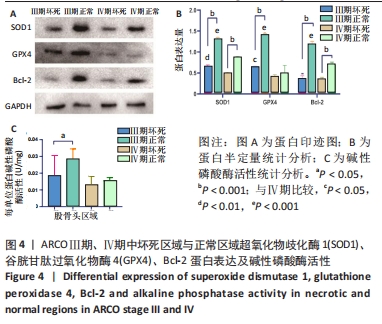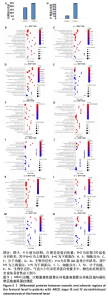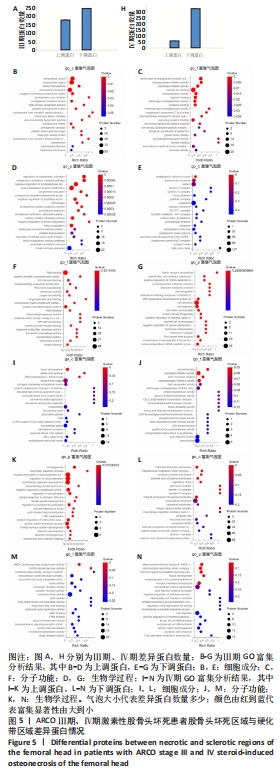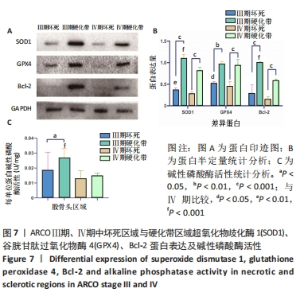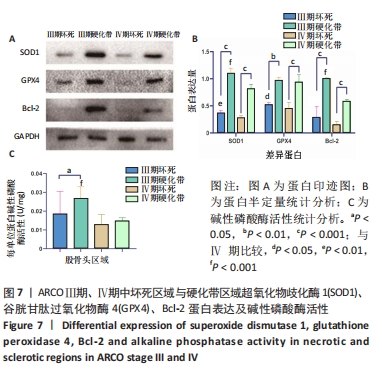Chinese Journal of Tissue Engineering Research ›› 2024, Vol. 28 ›› Issue (20): 3202-3208.doi: 10.12307/2024.334
Previous Articles Next Articles
The pathological progression of steroid-induced osteonecrosis of the femoral head caused by oxidative stress-induced osteoblast ferroptosis
Zhang Jiahao1, Liu Yuhao2, Zhou Chi2, Mo Liang1, Fang Hanjun2, Chen Zhenqiu2
- 1Guangzhou University of Chinese Medicine, Guangzhou 510405, Guangdong Province, China; 2First Affiliated Hospital of Guangzhou University of Chinese Medicine, Guangzhou 510405, Guangdong Province, China
-
Received:2023-04-23Accepted:2023-06-06Online:2024-07-18Published:2023-09-11 -
Contact:Chen Zhenqiu, MD, Chief physician, First Affiliated Hospital of Guangzhou University of Chinese Medicine, Guangzhou 510405, Guangdong Province, China Liu Yuhao, MD, Attending physician, First Affiliated Hospital of Guangzhou University of Chinese Medicine, Guangzhou 510405, Guangdong Province, China -
About author:Zhang Jiahao, Master, Physician, Guangzhou University of Chinese Medicine, Guangzhou 510405, Guangdong Province, China -
Supported by:“Double First-class” and High-level University Discipline Collaborative Innovation Team Project of Guangzhou University of Chinese Medicine, No. 2021xk46 (to CZQ); National Natural Science Foundation of China, No. 82104883 (to LYH); Guangdong Provincial Bureau of Chinese Medicine Research Project, No. 20231162 (to CZQ); National Center for Traditional Chinese Medicine Inheritance and Innovation Research Special Project, No. 2022QN07 (to FHJ)
CLC Number:
Cite this article
Zhang Jiahao, Liu Yuhao, Zhou Chi, Mo Liang, Fang Hanjun, Chen Zhenqiu. The pathological progression of steroid-induced osteonecrosis of the femoral head caused by oxidative stress-induced osteoblast ferroptosis[J]. Chinese Journal of Tissue Engineering Research, 2024, 28(20): 3202-3208.
share this article
Add to citation manager EndNote|Reference Manager|ProCite|BibTeX|RefWorks

GO富集的结果显示,在细胞成分上,Ⅲ期、Ⅳ期上调蛋白富集最为显著的前3 个均为细胞外区域(extracellular region)、细胞外空间(extracellular space)、含胶原蛋白的细胞外基质(collagen-containing extracellular matrix);下调蛋白富集最显著的前3 个是线粒体(mitochondrion)、线粒体基质 (mitochondrial matrix)、线粒体内膜(mitochondrial inner membrane, Ⅲ期)、细胞外外泌体(extracellular exosome,Ⅳ期)。 从分子功能上看,Ⅲ期、Ⅳ期上调蛋白富集最显著的前3分布在肝素结合(heparin binding)、钙离子结合(calciumion binding)、丝氨酸内肽酶活性(serine-type endopeptidase activity,Ⅲ期)、细胞外基质构成(extracellular matrix structural constituent,Ⅳ期);下调蛋白分布在氧化还原酶活性(oxidoreductase activity)、NAD结合(NAD binding)、电子转移活性(electron transfer activity)。 从生物学过程看,Ⅲ期、Ⅳ期上调蛋白富集最显著的前3 个为补体激活经典途径(complement activation,classical pathway)、补体活化的调节(regulation of complement activation)、补体激活(complement activation,Ⅲ期)、细胞代谢蛋白的过程(cellular protein metabolic process,Ⅳ期);下调蛋白分布在三羧酸循环(tricarboxylic acid cycle)、线粒体电子传递,NADH至泛醌(mitochondrial electron transport,NADH to ubiquinone,Ⅲ期)、脂肪酸代谢过程(fatty acid metabolic process,Ⅲ期)、电子传递链(electron transport chain,Ⅳ期)、支链氨基酸代谢(branched-chain amino acid catabolic process,Ⅳ期),见图2B-G,I-N。 对ARCO Ⅲ期、Ⅳ期所获得的富集最显著的前3 个的差异蛋白进行交叉汇总,筛选得出超氧化物歧化酶1、GPX4、B细胞淋巴瘤/白血病2基因(B-cell lymphoma-2,Bcl-2)显著性最大,并对其表达量进行检测,结果显示:Ⅲ期坏死区域超氧化物歧化酶1表达量为10.047 15,GPX4表达量为8.242 656,Bcl-2表达量为NA;正常区域超氧化物歧化酶1表达量为11.707 33;GPX4表达量为9.203 088;Bcl-2表达量为6.719 839。 Ⅳ期坏死区域超氧化物歧化酶1表达量为9.767 843;GPX4表达量为7.493 619;Bcl-2表达量为NA;正常区域超氧化物歧化酶1表达量为11.210 84,GPX4表达量为9.051 671,Bcl-2表达量为6.623 077,见图3。"
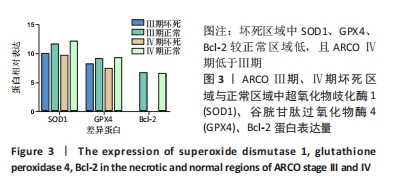

GO富集的结果显示,在细胞成分上,Ⅲ期、Ⅳ期上调蛋白富集最为显著的前3 个为血液颗粒(blood microparticle)、细胞外区域(extracellular region,Ⅲ期)、细胞外空间(extracellular space,Ⅲ期)、致密的核心颗粒(dense core granule,Ⅳ期)、RNA聚合酶全酶(RNA polymerase Ⅱ, holoenzyme,Ⅳ期);Ⅲ期下调蛋白富集最显著的前3 个是细胞外外泌体(extracellular exosome)、内质网腔(endoplasmic reticulum lumen)、胞浆(cytosol);Ⅳ期为线粒体内膜(mitochondrial inner membrane)、线粒体呼吸复合体Ⅰ(mitochondrial respiratory chain complexⅠ)、内吞囊泡膜(endocytic vesicle membrane)。 从分子功能上看,Ⅲ期、Ⅳ期上调蛋白富集最显著的前3分布在肽酶抑制剂活性(peptidase inhibitor activity)、丝氨酸内肽酶活性(serine-type endopeptidase activity,Ⅲ期)、内肽酶抑制剂活性(endopeptidase inhibitor activity,Ⅲ期)、类固醇结合(steroid binding,Ⅳ期)、肌动蛋白单体结合(actin monomer binding,Ⅳ期);Ⅲ期下调蛋白分布在RNA结合(RNA binding)、肽二硫氧化还原酶活性(peptide disulfide oxidoreductase activity)、SH3域绑定(SH3 domain binding);Ⅳ期分布在NADH脱氢酶(泛醌)活性[NADH dehydrogenase (ubiquinone) activity]、NADH脱氢酶活性(NADH dehydrogenase activity)、氧化还原酶活性,作用于NAD(P)H[oxidoreductase activity,acting on NAD(P)H]。 从生物学过程看,Ⅲ期、Ⅳ期上调蛋白富集最显著的前3 个为内肽酶负调节作用(negative regulation of endopeptidase activity)、补体激活经典途径(complement activation,classical pathway,Ⅲ期)、补体活化的调节(regulation of complement activation,Ⅲ期)、丝分裂形成(somitogenesis,Ⅳ期)、脂蛋白分解代谢过程(lipoprotein catabolic process);Ⅲ期下调蛋白分布在Notch受体处理(Notch receptor processing)、自然杀伤细胞介导的细胞毒性(natural killer cell mediated cytotoxicity)、mRNA分解代谢的正向调控(positive regulation of mRNA catabolic process);Ⅳ期分布在线粒体电子传递,NADH至泛醌(mitochondrial electron transport,NADH to ubiquinone)、线粒体呼吸链复合体Ⅰ(mitochondrial respiratory chain complex I assembly)、干扰素-γ介导的信号通路(interferon-gamma-mediated signaling pathway),见图5B-G,I-N。 对ARCO Ⅲ、Ⅳ期获得的富集最显著的前3 个差异蛋白进行交叉汇总,筛选得出超氧化物歧化酶1、GPX4、Bcl-2显著性最大,并检测其表达量,结果显示:Ⅲ期坏死区域超氧化物歧化酶1表达量为10.047 15,GPX4表达量为8.242 656,Bcl-2表达量为NA;硬化带区域超氧化物歧化酶1表达量为12.074 71,GPX4表达量为8.932 875,Bcl-2表达量为6.232 899。Ⅳ期坏死区域超氧化物歧化酶1表达量为9.767 843,GPX4表达量为7.493 619,Bcl-2表达量为NA;硬化带区域超氧化物歧化酶1表达量为11.435 61,GPX4表达量为8.288 634,Bcl-2表达量为6.147 253,见图6。"
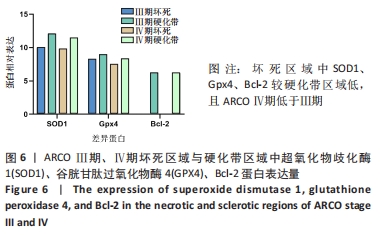
| [1] BAI R, FENG W, LIU WL, et al. Roles of osteocyte apoptosis in steroid-induced avascular necrosis of the femoral head. Genet Mol Res. 2016;15(1). doi: 10.4238/gmr.15017529. [2] CHANG C, GREENSPAN A, GERSHWIN ME. The pathogenesis, diagnosis and clinical manifestations of steroid-induced osteonecrosis. J Autoimmun. 2020;110:102460. [3] ZHU SY, ZHUANG JS, WU Q, et al. Advanced oxidation protein products induce pre-osteoblast apoptosis through a nicotinamide adenine dinucleotide phosphate oxidase-dependent, mitogen-activated protein kinases-mediated intrinsic apoptosis pathway. Aging Cell. 2018;17(4):e12764. [4] 章喻, 王利波, 戴薇薇. 糖皮质激素与铁死亡[J]. 生理科学进展,2022, 53(1):76-81. [5] 刘予豪. 龙血素B调节ROS活性促进激素性股骨头的修复[C]//2019楚天骨科高峰论坛暨第二十六届中国中西医结合骨伤科学术年会论文集.武汉:2019. [6] LIU F, WANG W, YANG L, et al. An epidemiological study of etiology and clinical characteristics in patients with nontraumatic osteonecrosis of the femoral head. J Res Med Sci. 2017;22:15. [7] ZHANG H, YU Z, SUN F, et al. Overexpression of CRABP2 inhibits dexamethasone-induced apoptosis in human osteoblast cells. J Orthop Surg Res. 2021;16(1):272. [8] 芮仞, 娄悦, 张先姚, 等. 细胞凋亡在激素性股骨头坏死发病机制中的研究进展[J]. 山西中医学院学报,2019,20(1):65-69. [9] VAN DER POL A, VAN GILST WH, VOORS AA, et al. Treating oxidative stress in heart failure: past, present and future. Eur J Heart Fail. 2019;21(4):425-435. [10] DIRCKX N, MOORER MC, CLEMENS TL, et al. The role of osteoblasts in energy homeostasis. Nat Rev Endocrinol. 2019;15(11):651-665. [11] NIE Z, DENG S, ZHANG L, et al. Crocin protects against dexamethasone‑ induced osteoblast apoptosis by inhibiting the ROS/Ca2+‑mediated mitochondrial pathway. Mol Med Rep. 2019;20(1):401-408. [12] HASSANNIA B, VAN COILLIE S, VANDEN BT. Ferroptosis: Biological Rust of Lipid Membranes. Antioxid Redox Signal. 2021;35(6):487-509. [13] SCINDIA PY, LEEDS MJ, SWAMINATHAN MS. Iron Homeostasis in Healthy Kidney and its Role in Acute Kidney Injury. Semin Nephrol. 2019;39(1):76-84. [14] LIU J, KUANG F, KROEMER G, et al. Autophagy-Dependent Ferroptosis: Machinery and Regulation. Cell Chem Biol. 2020;27(4):420-435. [15] 程峰, 张庸, 王祥, 等. 谷胱甘肽过氧化物酶GPX4在铁死亡中的作用与机制研究进展[J]. 现代肿瘤医学,2021,29(7):1254-1258. [16] Altunoluk B, Efe E, Kurutas EB, et al. Elevation of both reactive oxygen species and antioxidant enzymes in vein tissue of infertile men with varicocele. Urol Int. 2012;88(1):102-106. [17] Uotila J, Tuimala R, Pyykko K. Erythrocyte glutathione peroxidase activity in hypertensive complications of pregnancy. Gynecol Obstet Invest. 1990;29(4):259-262. [18] 吴微. 辨“形”论治下非创伤性股骨头坏死不同形态修复带与塌陷的相关性研究[D]. 广州:广州中医药大学, 2015. |
| [1] | Yang Yufang, Yang Zhishan, Duan Mianmian, Liu Yiheng, Tang Zhenglong, Wang Yu. Application and prospects of erythropoietin in bone tissue engineering [J]. Chinese Journal of Tissue Engineering Research, 2024, 28(9): 1443-1449. |
| [2] | Yang Yifeng, Ye Nan, Wang Lin, Guo Shuaicheng, Huang Jian. Signaling pathway of dexmedetomidine against ischemia-reperfusion injury [J]. Chinese Journal of Tissue Engineering Research, 2024, 28(9): 1464-1469. |
| [3] | Lou Guo, Zhang Yan, Fu Changxi. Role of endothelial nitric oxide synthase in exercise preconditioning-induced improvement of myocardial ischemia-reperfusion injury [J]. Chinese Journal of Tissue Engineering Research, 2024, 28(8): 1283-1288. |
| [4] | Shen Jiangyong, He Xi, Tang Yuting, Wang Jianjun, Liu Jinyi, Chen Yuanyuan, Wang Xinyi, Liu Tong, Sun Haoyuan. RAS-selective lethal small molecule 3 inhibits the fibrosis of pathological scar fibroblasts [J]. Chinese Journal of Tissue Engineering Research, 2024, 28(8): 1168-1173. |
| [5] | Pan Xiaolong, Fan Feiyan, Ying Chunmiao, Liu Feixiang, Zhang Yunke. Effect and mechanism of traditional Chinese medicine on inhibiting the aging of mesenchymal stem cells [J]. Chinese Journal of Tissue Engineering Research, 2024, 28(7): 1091-1098. |
| [6] | Wang Wen, Zheng Pengpeng, Meng Haohao, Liu Hao, Yuan Changyong. Overexpression of Sema3A promotes osteogenic differentiation of dental pulp stem cells and MC3T3-E1 [J]. Chinese Journal of Tissue Engineering Research, 2024, 28(7): 993-999. |
| [7] | Zhang Yaru, Chen Yanjun, Zhang Xiaodong, Chen Shenghua, Huang Wenhua. Effect of ferroptosis mediated by glutathione peroxidase 4 in the occurrence and progression of synovitis in knee osteoarthritis [J]. Chinese Journal of Tissue Engineering Research, 2024, 28(4): 550-555. |
| [8] | Wei Yuanxun, Chen Feng, Lin Zonghan, Zhang Chi, Pan Chengzhen, Wei Zongbo. The mechanism of Notch signaling pathway in osteoporosis and its prevention and treatment with traditional Chinese medicine [J]. Chinese Journal of Tissue Engineering Research, 2024, 28(4): 587-593. |
| [9] | Cao Sheng, Kong Lingwei, Xu Kun, Sun Zhijie. Effect of gelatin methacryloyl hydrogel loaded with salvianolic acid B on intervertebral disc degeneration [J]. Chinese Journal of Tissue Engineering Research, 2024, 28(3): 380-386. |
| [10] | Zhu Zhiqi, Yuan Sijie, Zhang Zilin, Ji Shijie, Meng Mingsong, Yan Anming, Han Jing. Mechanism underlying the effect of Liuwei Dihuang Pill on osteolysis and osteogenesis induced by titanium particles [J]. Chinese Journal of Tissue Engineering Research, 2024, 28(3): 392-397. |
| [11] | Hai Zhen, Ning Zhongping. Protective effect of salidroside on angiotensin II-induced fibrosis in cardiac fibroblasts [J]. Chinese Journal of Tissue Engineering Research, 2024, 28(20): 3137-3142. |
| [12] | Ji Weixiu, Bai Yi, Wang Shuo, Zhao Yungang. Protective effect and mechanism of 3-nitro-N-methyl salicylamide on the skeletal muscle of rats with limb ischemia-reperfusion injury [J]. Chinese Journal of Tissue Engineering Research, 2024, 28(20): 3164-3169. |
| [13] | Sun Yuan, Wang Qingbo, Pi Yihua, Lu Chunmin, Xu Chuanyi, Zhang Yan. Effects of early and late aerobic exercise on right heart failure induced by monocrotaline in rats with pulmonary hypertension [J]. Chinese Journal of Tissue Engineering Research, 2024, 28(2): 177-185. |
| [14] | Lin Tianye, Wu Zhiming, Zhang Wensheng, He Xiaoming, He Mincong, Zhang Qingwen, He Wei, Wei Qiushi, Li Ziqi. Mechanism of compound Shengmai Chenggu capsule in the repair of steroid-induced osteonecrosis of the femoral head [J]. Chinese Journal of Tissue Engineering Research, 2024, 28(2): 200-207. |
| [15] | Chen Simin, Hu Yingjun, Yan Wenrui, Ji Le, Shao Mengli, Sun Ze, Zheng Hongxing, Qi Shanshan. Establishment and evaluation of a streptozotocin-induced diabetic encephalopathy rat model [J]. Chinese Journal of Tissue Engineering Research, 2024, 28(2): 237-241. |
| Viewed | ||||||
|
Full text |
|
|||||
|
Abstract |
|
|||||
